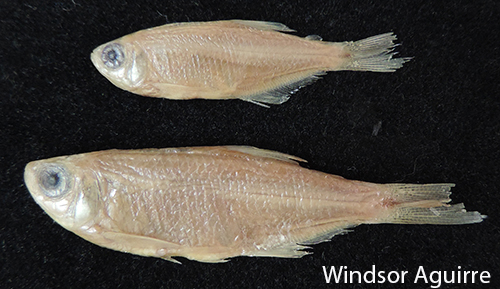Characidae - Phenacobrycon henni (Eigenmann, 1914) |
 |
| **Photographs of paratypes from Field Museum of Natural History** |
| SOURCE FOR OCCURRENCE IN ECUADOR: There are many references for its occurrence in the area (e.g., Eigenmann, 1922; Eigenmann, 1929; Ovchynnyk, 1971; Roberts, 1973; Gery, 1977). |
| ORIGINAL DESCRIPTION: Eigenmann, C.H. , A.W. Henn, and C. Wilson. 1914. New fishes from western Colombia, Ecuador, and Peru. (Contrib. Zool. Lab. Ind. Univ. No. 133.). Indiana University Studies No. 19: 1-15. |
| TYPE SPECIMENS: |
| TAXONOMIC STATUS: Valid (Eschmeyer and Fricke, 2011). |
| RANGE ECUADOR: Eigenmann reports this species as occurring along the Western slope of southern Ecuador. However, it may be endemic to the Guayas basin (Roberts, 1973). |
| RANGE OUTSIDE OF ECUADOR: None. |
| COLLECTIONS IN ECUADOR: |
| MAXIMUM SIZE: 5.3 cm. (Eigenmann, 1929). |
| DISTINGUISHING FEATURES: Phenacobrycon henni differs from other characids in the region by the following combination of characters: first ten and last ten rays of the anal fin of the male with hooks, lower caudal fulcra of the male not separated from the rest and not prominent, middle caudal rays of the male with a glandular scale; cheeks entirely covered by the suborbital (Eigenmann, 1922). Maxillary teeth in the form of two elonagate blades with sharp edges. Premaxillary with three teeth in the front row and four in the back row. Mandible with five teeth. Dorsal fin with ten rays, anal fin with 33 rays, 12+11 Gill rakers (Jimenez et al., 2015). Live P. henni are similar in coloration to Landonia and exhibit a silvery coloration with bluish reflections, no humeral spot. The upper lobe of the caudal fin is yellow with black along the margin, the lower lobe of the caudal fin may be clear or yellow, but the coloration is always more intense on the upper lobe (Roberts, 1973). |
| ECOLOGY: Roberts (1973) collected P. henni in backwaters of the Rio Vinces and Rio Cristal, and in isolated pools off the Rio Vinces. This species appears to feed largely on arthropods. Stomach contents of specimens collected during the dry season from the Rio Vinces included Springtails (Collembola - most common food item), water striders (Hemiptera, Gerridae - second most common food item), larval dipterans, spiders, Acarina, pygmy mole crickets (Orthoptera, Tridactylidae), Hymenoptera, and Coleoptera (Staphylinidae and Limnichidae) (Roberts, 1973). No fish scales or fin rays were found. In contrast, a few specimens of the morphologically similar Landonia latidens had fish scales, fin rays and filamentous algae in their stomachs suggesting that these species may differ in their feeding habits. More data are needed to confirm this hypothesis. |
| ECONOMIC IMPORTANCE: This species is not directly exploited as a food fish because of its small size. |
| CONSERVATION STATUS: NA, although this species is not exploited directly. No specimens were collected by Aguirre et al., during collections carried out in southwestern Ecuador in July, 2008, suggesting that this species may not be terribly common. |
| LINK TO FISHBASE PAGE: Click here for link |
| SPECIES PROFILE CREATED BY: Enrique Laaz |
| SPECIES PROFILE CONTRIBUTORS: Windsor Aguirre |
|
|
|
|
|
